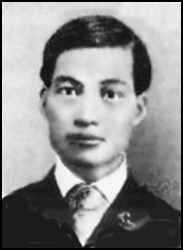
Page 2. |
 |
|
from China Radio International |
|
MAKES LONG FLIGHT OAKLAND ENQUIRER, Sept. 23, 1909 Collection of Oakland History Room/Oakland Public Library He met with an accident to the propeller that brought his flight to an end before he had tried high flying. The bolt holding the propeller to the shaft snapped after he had been in the air 20 minutes and the machine came to the ground. Fung Joe Guey was bruised in the fall. He made his flight near the old Dingee residence, back of Piedmont, about 6 o'clock Tuesday night. Chung Doo Nam, a Chinese restaurant keeper of 367 Ninth street, who is one of his backers, assisted him in putting the aeroplane together and was with him at the time he rose. A young Chinese disciple of the aviator and a few farmers of the neighborhood were the other spectators. The aeroplane rose from the ground, but never reached a height of more than 10 or 12 feet, as Fung Joe Guey did not wish to venture higher until he had fully tested its dirigibility. He followed the rise and fall of the hilly ground without trouble, the aeroplane responding well in this respect. The aeroplane consists of two planes 25 feet long and 6 feet 3 inches broad. placed one above the other, like other planes. It was driven yesterday by a six horse-power engine. The improvement that the inventor claims for his own consists of an extra plane between the large ones, stationed hear the rudder of the machine. He says that this extra plane catches a current of air that the rudder can use. Fung Joe Guey says he will fly again. He plans to constRUct another aeroplane on the same lines a the old one, but stronger. It is to be built of steel tubing and silk and will be driven by a more powerful engine. |
|
FIRST TO FLY ON COAST Fung Joe Guey Local Machinist Makes Successful Flight in Bi-Plane MOTOR AND AEROPLANE ARE OF HIS OWN BUILD Accident to Propeller Causes Machine to Plunge to the Ground OAKLAND ENQUIRER, Sept. 23, 1909 Collection of Oakland History Room/Oakland Public Library Fung was preparing to make another turn when a sudden stoppage of the propellor and a quick drop of the stern of the craft threw the machine heavily to the earth. Fung was thrown out uninjured. The screws holding the driving wheel on the propeller shaft had broken under the strain. The failure of the propeller had let the bi-plane drop astern foremost to the ground. The rear starting wheels were bent and twisted but the impact. The Chinese aviator has been working on his machine since last May in his little shop at 359 East Ninth street, Oakland. He had it hauled to the lonely spot in the Piedmont hills last Thursday with the aid of three other Chinese enthusiast he reassembled the parts and prepared for flight. |
|
TO FLY AT HOME Fung Guey to Leave for China, There to "Show the Natives." OAKLAND Tribune, Feb. 20, 1911 Collection of Oakland History Room/Oakland Public Library A Curtiss biplane, in which the Chinese has made experimental flights at Elmhurst, will be shipped on the steamre. The ship as constructed by Fung Guey himself and is 29 1/2 feet long. Fung Guey goes to China endorsed by the Chinese consul of San Francisco and by leading merchants and although the Chinese government has nothing to do with his experiments in aviation, it is to be a close observer of what he can do. A good part of Chinatown attended the farewell banquet given recently in a Chinese restaurant. |


|